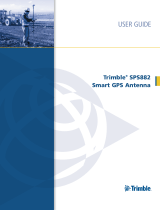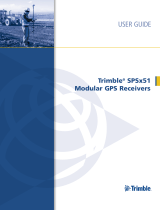Page is loading ...

SCS900 and a Ohmex
Brief instructions on how to use SCS900 and a Ohmex echo sounder for a small
hydrographical survey.
In Trimble’s SCS900 software it is possible to combine the depths of an Ohmex echo
sounder and the positions of GPS or Optical instruments. In order to do so, a dll and
program should be stored in the following folder \Program Files\Trimble SCS900
there are different programs available, one for each type of data logger. In this
document the TSC2 was used (Windows Mobile 5)
It is possible to create a shortcut of the executable in the folder \Windows\Start Menu
enabling the software to be started from the start menu.
First of all, the echo sounder should be connected to the data logger, this can be
done using a serial connection, i.e. via Bluetooth (it is also possible to use a serial
cable if the GPS receiver supports Bluetooth)
Pairing Bluetooth devices:
Assuming the Sonarmite is not paired yet, go to Start>Settings>Connections and
select Bluetooth. Make sure the checkboxes are both ticked (turn on Bluetooth and
make this device discoverable to other devices) now select the page devices. At this
stage, turn on the already charged Sonarmite by connecting the transducer (the
green light flashes briefly) now select new partnership The scanning procedure
Starts. After all discoverable devices are found, select the Sonarmite (usually named
SM****** where ***** stands for the serial number) and select Next. Enter the

passkey (usually this is 1111) and enter the partnership settings, by checking the
serial port service. After this, the Sonarmite is visible under the tab Devices.
After this, the serial port has to be assigned by selecting the tab COM ports and
select New Outgoing Port. Again select the Sonarmite and select Next. Now
deselect (uncheck) secure connection and select Finish.
Remember the comport number assigned to this service (in this case COM 8)
Starting a Hydrographic survey.
In order to combine the depths from the SonarMite and the positions in SCS900 it is
essential the SonarMite software is started and remains running during the survey.
Starting the SonarMite Software
If a shortcut is created, select Start>SMtsc. If the shortcut is not created, find the
executable located under \Program Files\Trimble SCS900 If the software is not
registered , enter the registration key by selecting the yellow question mark (?) the
activation key is 19652

Now select Device>SonarMite and select the previously assigned COM port (in this
case COM 8) Leave the other settings as per default (9600,8,n,1 no flow control)
Select OK and the echo sounder should now return depths. It is possible to fine-tune
the Quality threshold, it is advised to leave it low in order to pass all data. Leave the
SonarMite software running and continue with the next part. If you encounter
problems (unable to connect etc) reset the TSC2 (switch Bluetooth back on) and
retry. If this fails, start from the beginning (pairing devices)
New Feature:
In the latest version of the SonarMite SW or SCS900, it is now possible to set the
sound velocity. To do this, double tap the center of the SonarMite screen and the
following display appears. The functions
thatNow select Device>SonarMite and
select the previously assigned COM port
(in this case COM 8) Leave the other
settings as per default (9600,8,n,1 no flow
control) Select OK and the echo sounder
should now return depths. It is possible to
fine-tune the Quality threshold, it is
advised to leave it low in order to pass all
data. Leave the SonarMite software
running and continue with the next part. If
you encounter problems (unable to
connect etc) reset the TSC2 (swIn this
document I assume the user is familiar with the basics of SCS900. The concept of
Sites, Designs and Work orders are assumed as common knowledge. If not, please
refer to the SCS900 manual. If a folder structure is prepared by the Survey office,
simply start SCS. If not, it is assumed the following files are selectable on the data
logger:
• Design (DXF or TTM)
• Site Calibration (or DC file)
• Control points or Bench Marks (TXT)
• Background map
In this example we take this step, which is not required if a folder structure is
prepared by the Survey office.

Before starting the Hydrographic survey, be sure to check the system setup by
measuring a bench mark.
Start SCS900 and create a new Work Order Select the site or create a new one (A
site contains the items mentioned above) in this case a new site is created.
In the new site, the various files are selected, a minimum is the site calibration file
(DC file) in order to get the proper coordinate system, or a csv file containing control
points (Since it is recommended to check the system setup, a .csv file is important).
Currently this site calibration can contain a Geoid model, but CAN NOT contain a
shiftgrid!..
If no calibration file (DC) is at hand, it is possible to calibrate the site using the known
points in the .csv file. Simply select calibrate site in the Systems Setup menu
System Settings
It is possible to set the required accuracies under Settings , this can vary from one
jobsite to another. There is a difference in acceptance criteria (will it store a position
and depth or not) and the Calibration tolerance (will it accept a System Setup check)

System Setup
No wit is time to start the rover, Select System Setup and Setup Rover, or go directly
to Measure Surface. Topo Surface and SCS900 will prompt you to set up a GPS
rover. In this process, follow the instructions on screen
The instructions will take you step by step trough the system setup. It will ask you if
the receiver is connected by cable or Bluetooth (a), if it uses an internal, external
radio or other correction method (b), and the coverage map grid size and antenna
height (c)
Once started , SCS900 will ask you if you want to check the system setup, it is
advised to do so.
After the System Setup is completed and checked, the topo survey can start. Bear in
mind there are survey methods, shown in the top left corner. These are Standing (red
figure) Walking (yellow figure) and on vehicle mode (yellow quad) Those methods
automatically set the position update rate and the different antenna heights.
Changing this mode can be done by clicking it. For a hydrographic survey, select the
vehicle mode (click here) and enter the height from the bottom of the transducer to
the bottom of the antenna.
A B C

Finally select the measurement density required for the job, this will make the system
log at a minimum interval or elevation change.
Are you recording the bottom?
In order to check if the system is indeed setup to record the bottom, look at the
difference of the elevation shown on top of the screen and the recorded point
elevation. To annotate points with their elevation, select the take the following steps.
Select the button 123 Des (buttons may be changed by selecting the black triangle)
Check display Point Elevations and select OK.
Remember that if loads of points are stored, this option can slow down the CE device
and make the map hard to read, so switch of again if required.
Now Start a measurement, SCS900 will prompt you for a point name (this will
increment automatically) and a code (tip, this code can be used to identify a cross
section number or profile number) After selecting OK again, a point is measured and
stored, annotated with the actual height. In this example, the elevation of the bottom
of transducer was 5.330, the measured depth was 0.377 (bucket) and the bottom is
in that case 4.953.
Complete Work Order
Once finished with the survey, the export files are written in the export folder those
files consist of a record.TXT and report.txt optional a DXF can be written but
remember this can consume a lot of memory.

/














